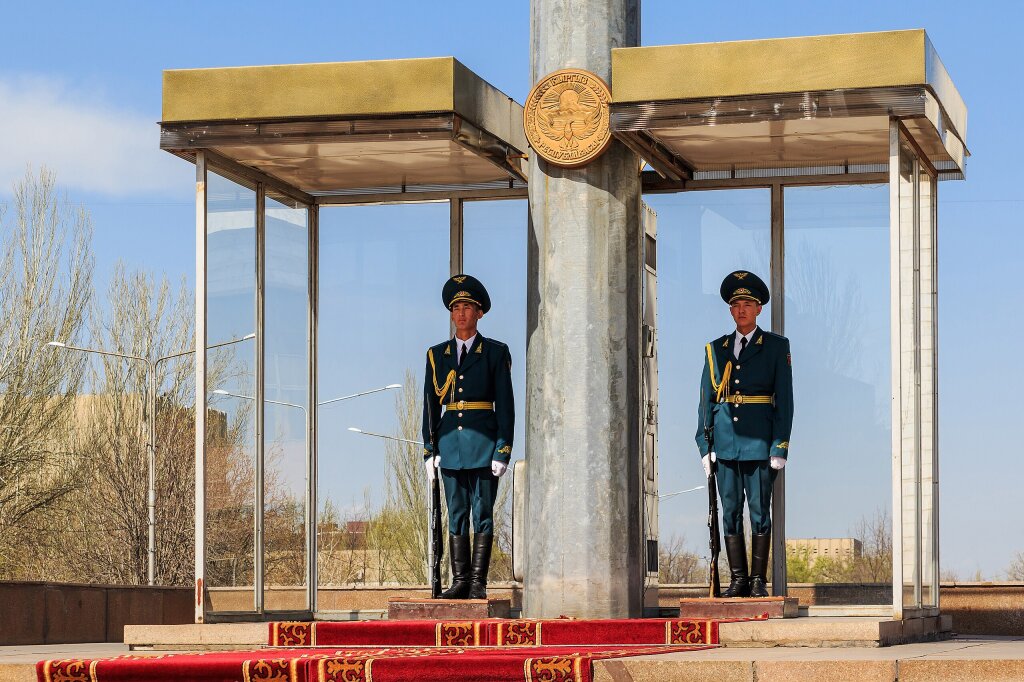This post was a Judges' Choice winner in the Jordan Center Blog's fourth annual Graduate Student Essay Competition.
Roksana Gabidullina is an independent researcher who holds an MA in Eastern European, Russian, and Eurasian Affairs from Georgetown University’s School of Foreign Service.
In June 2023, President of Kyrgyzstan Sadyr Japarov approved the third military doctrine since the country gained independence in 1991. Stating that he had personally overseen the development of this doctrine, he highlighted that since “80 percent of the 40 administrative regions [were] directly connected to neighboring countries” and developments on Kyrgyzstan’s borders and in other parts of Central Asia “directly and indirectly” affected Kyrgyzstan, it was “very important” that the country increase its defense capability to respond to possible challenges and threats.
According to the Chief of the General Staff of the Armed Forces, Erlis Terdikbaev, the new military doctrine was needed given the new Constitution and new concept of national security adopted in 2021. Moreover, “changes in the military-political situation in the world and Central Asia,” he said, underscored the need to “strengthen requirements in response to modern threats.”
Although all sections of the new doctrine were updated, much of the language remains the same as in previous versions. At the same time, changes to the introduction, as well as to sections on threats and policy for ensuring security and the development of the armed forces, underline the profound effects that conflicts since 2021 have had on the security outlook of Kyrgyzstan’s current regime, as well as on state policy on rearmament and the modernization of the military. The new doctrine responds to the perception of increasingly numerous and technologically sophisticated threats, along with changing regional and global security environments on the regional and global scales. In an effort to protect Kyrgyzstan’s “independence and integrity” and create “deterrents” to threats from without, the state is now seeking to modernize its military and generally increase its defensive capabilities.
The doctrine’s mentions of Kyrgyzstan’s borders as well as of developments in wider Central Asia and the world seem to relate to armed conflicts between Kyrgyzstan and Tajikistan in 2021 and 2022, US and allied withdrawal from Afghanistan in 2021, and Russia’s full-scale invasion of Ukraine in 2022. It was precisely in October 2021, following the unprecedented border clash between Kyrgyzstan and Tajikistan in April, as well as the allied withdrawal from Afghanistan in August of that year, that President Japarov announced the drafting of a new national security concept. This concept is a broad policy document outlining the nation's overarching goals and priorities for ensuring its security. In turn, the new concept necessitated the development ofr a new military doctrine that would focus on concrete principles guiding the armed forces.
The national security concept was adopted two months after the announcement, in December 2021. The new military doctrine, however, would not be approved for another two years. Its final release to the public would follow Russia’s invasion of Ukraine in February 2022, and the latest and deadliest border conflict between Kyrgyzstan and Tajikistan in September 2022. In remarks in 2023, Minister of Foreign Affairs Jeenbek Kulubayev highlighted specific incidents during the clashes in 2021 and 2022, calling for the new doctrine to include a reference to “external aggression.” Although this phrase didn’t make it into the final version of the doctrine, both the Foreign Minister and the President underlined the importance of Kyrgyzstan bolstering its defensive capabilities in response to current threats and challenges.
Threats and the state of world security
In contrast to previous doctrines, the section on the general military-political situation in the most recent version is almost three times as long, describing a world besieged by emerging new armed conflicts and changes in interstate and interregional relations that act as “catalysts” for extremism and protests. Moreover, the reader learns that there is “targeted large-scale information technology and information-psychological influence.” Other justifications for the more robust military development that the rest of the document articulates include a “crisis of trust”’ decline in the international economy; and an international sanctions policy that is contributing to the “destabilization” of the world and the region.
The 2023 Kyrgyz military doctrine also introduced two new terms: “local wars”, which are limited to countries bordering one another, and “regional wars”, which include two or more states or coalitions using conventional weapons, or potentially nuclear arms and other weapons of mass destruction. These changes point to the destabilizing influence and negative economic-political impact of Russia’s invasion of Ukraine and the resulting global responses and sanctions.
On a more local front, the threat emanating from border conflicts is one of the doctrine’s recurring features. Here, too, there are two new terms: “border incident”, which involves incidents at the border arising from “illegal actions” by citizens, local authorities, and military personnel, and “border conflict”, which involves an “open confrontation” and “organized clash” of people with “opposing interests” that cross borders. Against the backdrop of an unstable world, the doctrine’s authors predict that the republic is “likely” to deal with attempts to “forcefully resolve issues” at undemarcated sections of the border.
Border problems are mentioned again in the context of sources of military threats. Per the document’s authors, border conflicts present a “threat to the inviolability of the State border” with the potential to cause “military aggression against the backdrop of incomplete processes for [the border’s] delimitation and demarcation.” Since Kyrgyzstan concluded its demarcation with Uzbekistan in 2022, the border conflicts mostly, if not only, refer to the yet-to-be- delimited borders with Tajikistan.
The focus on this particular border is also apparent because of the attention the doctrine’s authors accord affected regions bordering Tajikistan. In January 2022, Chairman of the State Committee for National Security Kamchybek Tashiev promised that recently purchased military equipment would be sent to the Batken region, a region that Kyrgyzstan claimed was invaded by Tajikistan in September 2022. This focus on bolstering the Batken border region alongside the new terms of the 2023 doctrine makes clear that Bishkek anticipates an increasingly unstable regional environment that will likely draw military action on the border.
Military policy and response
The effect of border-related and wider geopolitical conflicts is apparent in the doctrine’s sections on military development as well as the regime’s concrete policy measures. The doctrine lays out several tasks meant to ensure security along undemarcated borders and negotiate an unstable geopolitical situation. These include improvements to the air defense system as part of the joint agreement with members of the Collective Security Treaty Organization (CSTO), and further provision of equipment to the armed forces. Kyrgyzstan’s authorities have already taken important steps to fulfill both of these tasks.
According to President Japarov, Kyrgyzstan has neglected the armed forces, keeping defense capabilities minimal for budget reasons. However, he has stated that he intends to redress this neglect, claiming that, “for the first time in 30 years,” Kyrgyzstan has “purchased the modern weapons required to protect borders and citizens.” Some of these weapons are apparently types with “no analogues in Central Asia.”
Following the April 2021 border clash with Tajikistan, in which Tajikistan’s forces reportedly inflicted more damage than Kyrgyzstan’s, Bishkek began increasing its acquisitions of military equipment. In the fall of 2021, Kyrgyz authorities purchased their first drone model, the TB2 Bayraktar drone, then bought three other Turkish drones as well as Russian and Chinese surveillance UAVs (unmanned aerial vehicles). The government also purchased conventional weapons like air defense missile systems, as well as a range of armored vehicles for the border services.
In addition to these purchases, the government has upgraded and refurbished the country’s missile systems and helicopters, with plans for additional acquisitions. Spending was in line with these acquisitions. In 2021,, Kyrgyzstan’s spending on armaments increased tenfold, reaching 32 billion Kyrgyz som, up from 3.5 billion in 2020. Spending continues unabated, totaling 43 billion som in 2022 and 40 billion som in the first half of 2023 alone.
Like previous military doctrines, the latest one prioritizes security via cooperation with other countries and organizations like the CSTO. Although Kyrgyzstan canceled planned CSTO exercises in October 2022, prompting speculation that Russia was losing its influence in the country, President Japarov has since confirmed the importance of this relationship by ratifying on 12 October 2023 an August 2022 agreement on unified air defense with Russia. According to Japarov, this joint air defense system will “ensure more reliable protection of the airspace of both countries” and “ increase the security of national interests.”
Conclusion
The military doctrine reflects the regime’s understanding of the global geopolitical situation and the threats emanating from it. In the view of President Japarov and his administration, global political and military instability has increased insecurity and the likelihood that Tajikistan, in particular, might elect to resolve border issues “by force.” It is therefore vital for Kyrgyzstan to invest in the modernization of its military. The steady rearmament process since the April 2021 border clash with Tajikistan and the August 2022 agreement on unified airspace with Russia can be understood as part of this trend.
Despite their recent military investments, Kyrgyzstan’s authorities stress that they prefer to resolve issues via diplomatic means—a claim that may be of little comfort to Tajikistan as it watches Kyrgyzstan’s military acquisitions. Tajikistan has itself engaged in an arms race with its neighbor, for instance by acquiring drones in 2022. For his part, Japarov seems determined to outpace Tajikistan, declaring that the billions of dollars spent on military purchases are “only the beginning.”



